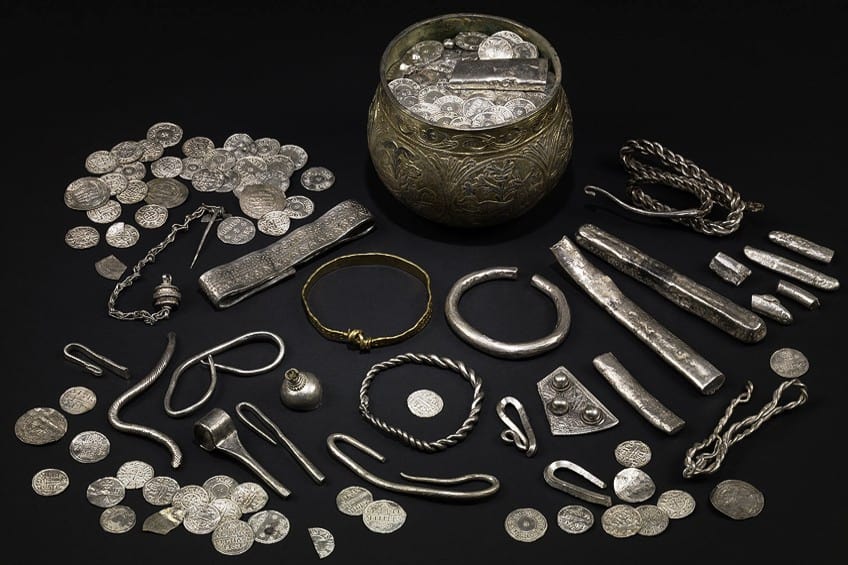Viking Artifacts – Exciting Viking Relics That Have Been Found
Popular culture is full of images of the Vikings, yet how much of what we see in the movies and on television is accurate? What were the people like who created the Viking artifacts found in museums today? Perhaps by exploring a few Viking relics and Norse mythology artifacts, we will be able to get a better understanding of the Viking people. Let’s delve into the world of Norse artifacts!
Contents
- 1 Exploring Viking Relics and Norse Mythology Artifacts
- 1.1 The Spillings Hoard (c. 675 AD)
- 1.2 Hunterston Brooch (c. 700 AD)
- 1.3 Valkyrie from Hårby (c. 800 AD)
- 1.4 The Repton Warrior (c. 860 AD)
- 1.5 The Watlington Hoard (878 AD)
- 1.6 Gokstad Ship (c. 890 AD)
- 1.7 Ulfberht Viking Sword (c. early 9th Century)
- 1.8 Oseberg Heads (c. 9th Century)
- 1.9 Coppergate Excavation (c. 9th Century)
- 1.10 The Harrogate Hoard (c. 900 AD)
- 1.11 Cuerdale Hoard (905 AD)
- 1.12 Hiddensee Hoard (c. 10th century)
- 1.13 The Gjermundbu Helmet (c. 10th Century)
- 1.14 Ardnamurchan Burial (c. Early 10th Century)
- 1.15 Hogback Tombstone (c. 10th Century)
- 1.16 Roskilde 6 (1025)
- 1.17 Winchester Manuscript (1031)
- 1.18 The Lewis Chess Pieces (c. 1150 AD)
- 1.19 Weighing Scales (c. 1000)
- 2 Frequently Asked Questions
Exploring Viking Relics and Norse Mythology Artifacts
Although the actual reason why Vikings first decided to travel by ship to other regions is unclear, historians have put forward a few potential scenarios. For the inhabitants of Sweden, Denmark, and Norway before the 7th century, agriculture was the main source of earning a living, and there were very few towns. Even though most of the land was rural, an increase in the population lead to a situation where the plots of subdivided land became too small to produce profitable harvests. There were also tribal conflicts as various chiefs vied for territorial dominance.
It has been hypothesized that these factors, along with stories of Western riches brought back by merchant traders, lead to various tribes from the area traveling across the North Sea to countries such as Ireland, Scotland, and France in search of treasures and fortune.
Countless Viking artifacts have been unearthed in the regions that they plundered, as well as in the area from which they had traveled. To learn more about these seafaring warriors, let us explore the most significant Viking relics, from the magnificent Viking swords to the most valuable Viking glass.
The Spillings Hoard (c. 675 AD)
| Date | c. 675 AD |
| Artist | Unknown |
| Medium | Coins |
| Current Location | Gotland Museum, Sweden |
It is not often that buried treasure is discovered in regular everyday life. However, in 1999, on the Swedish island of Gotland, out in the center of the Baltic Sea, this is exactly what happened. They chose the site using a metal detector since 150 silver coins had previously been recovered there.
However, when Ström’s metal detector flashed “overload” in a field, he realized they had hit gold.

The Spillings hoard contains 14,295 coins. The Spillings treasure may have been buried near some of the island’s greatest harbors during the Viking Age. Gotland’s location in the Baltic Sea, near Sweden, made it a tactically vital stop for Viking sailors, invaders, and merchants traveling around the region.
The silver pieces were supposedly enough to cover Gotland’s whole tax receipts for five years.
Hunterston Brooch (c. 700 AD)
| Date | c. 700 AD |
| Artist | Unknown |
| Medium | Gold, silver, amber |
| Current Location | National Museum, Scotland |
Many Viking relics that have been found at Viking-age sites were not created by the Vikings themselves, but rather by the people they had invaded. As invaders, they not only destroyed villages but also raided anything of perceived value and appropriated it for their purposes.
Such is the case with the Hunterston Brooch which is adorned with Celtic patterns, yet the words “Mælbrigða owns this brooch” have been etched into it in a Norse runic alphabet.

There are several places the brooch could have originated, ranging from a royal site in western Scotland to England, and Ireland. Certain aspects, such as the filigree are reminiscent of English metalwork, while much of the detail recalls Irish traditional designs.
Valkyrie from Hårby (c. 800 AD)
| Date | c. 800 AD |
| Artist | Unknown |
| Medium | Silver |
| Current Location | National Museum of Denmark, Denmark |
In 2013, the only three-dimensional Valkyrie pendant unearthed to date was discovered in Denmark. These mythological beings were said to be feminine spirits of warfare that escorted the slain to Valhalla in service of Odin. As with other Norse mythology artifacts from this period, these types of figurines could also represent Viking-age goddesses and other supernatural agents such as spirits.
Women were not traditionally warriors in Viking society, yet they held high positions of status within the tribe as sorceresses.
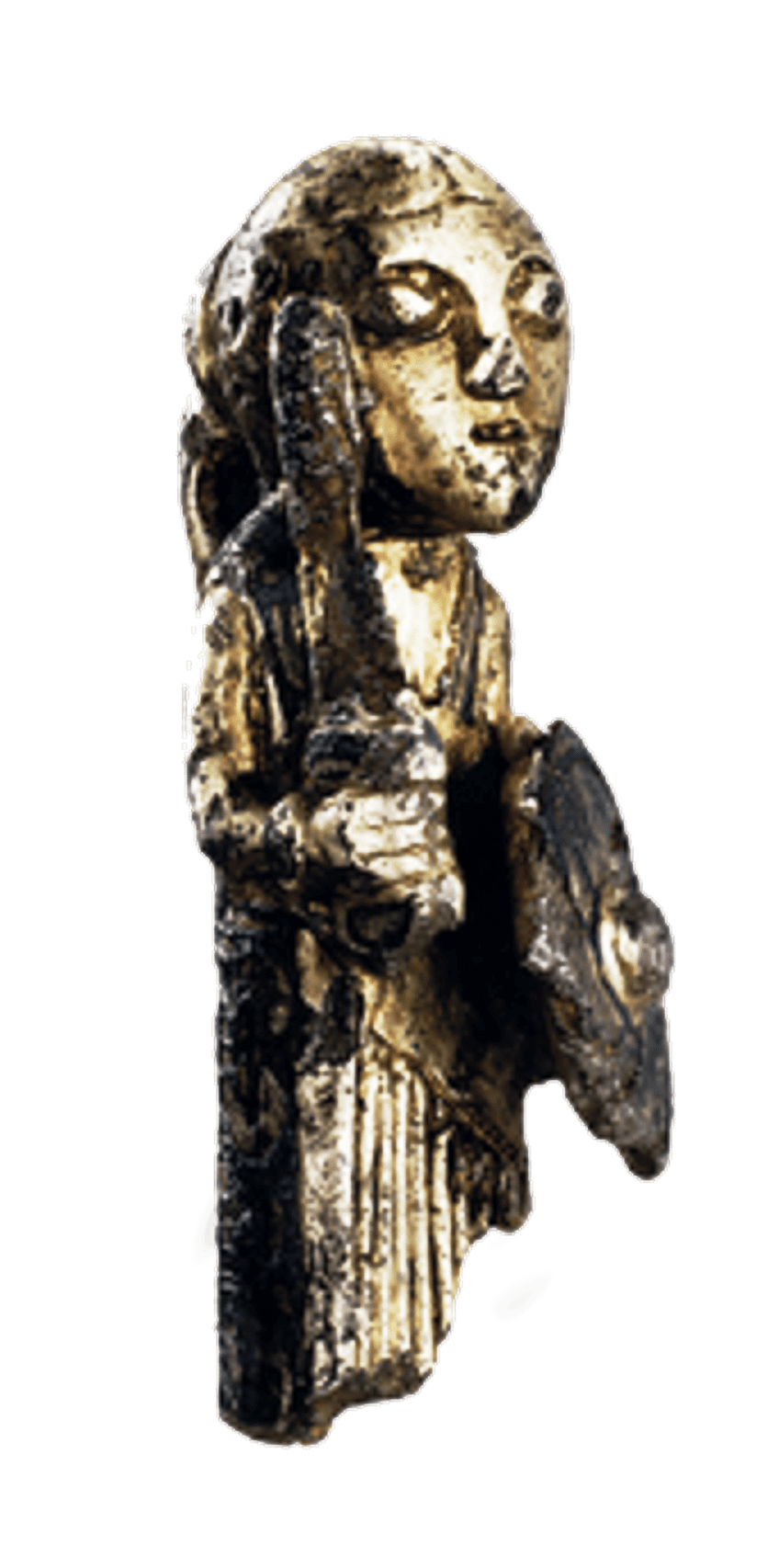
Other Viking relics that were unearthed from the same region include various bronze ornaments, silver coins, and a golden rod. The silver figurine’s eyes are clearly defined and the Valkyrie has been portrayed brandishing a Viking sword and shield and wearing a long skirt.
The Repton Warrior (c. 860 AD)
| Date | 860 AD |
| Artist | Unknown |
| Medium | Gravesite |
| Current Location | Derbyshire, England |
The ‘Repton warrior’ is little understood, but what is definite is that he met a horrific end; the Viking man was discovered in the 1980s with a slash to his leg that is assumed to have removed his penis. The site of the corpse of the ninth-century warrior has been nicknamed “England’s best-known Viking grave,” and he was discovered in the Derbyshire village of Repton in the 1980s side-by-side with yet another, younger man.
Possible hypotheses concerning the two men’s identities have evolved through time; initially, it was assumed that the younger of the two was the Repton warrior’s weapon carrier.
However, a DNA study has indicated that the duo was first-degree cousins, lending validity to the claim that they headed the Great Army that terrorized England in the 860s and 870s AD. According to Cat Jarman, Viking raiding might be “a family enterprise.”
The Watlington Hoard (878 AD)
| Date | 878 AD |
| Artist | Unknown |
| Medium | Coins and Jewelry |
| Current Location | Ashmolean Museum, Oxford, England |
The Watlington hoard is a relatively modern discovery that has contributed greatly to our knowledge of Viking civilization. In 2015, amateur metal detectorist James Mather discovered an incredible collection of Viking silver in a farm field in Oxfordshire.
It comprises 186 coins, as well as various ingots and pieces of jewelry, and is considered to date from after Alfred the Great’s victory against the Vikings at Edington.
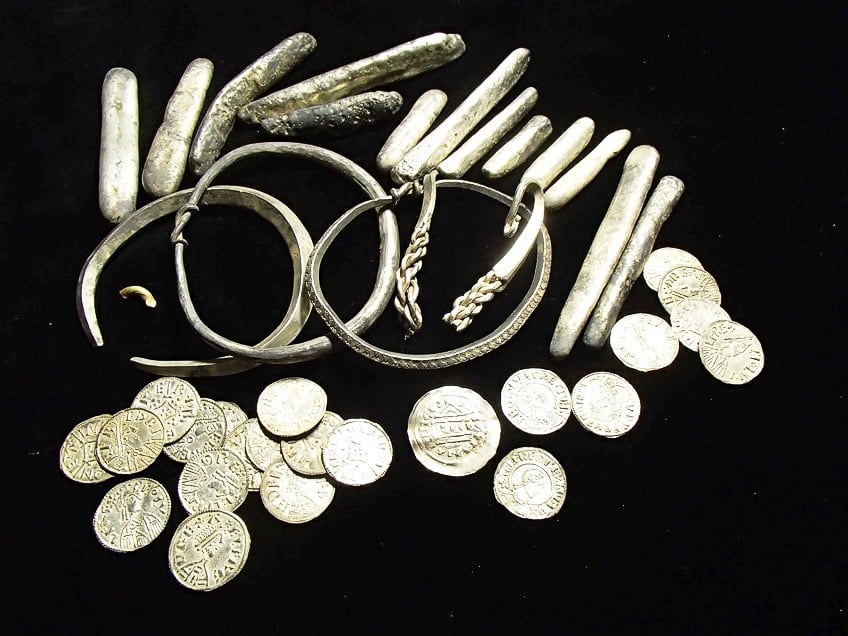
The ‘Two Emperors’ penny, of which there are 13 specimens, is perhaps the most spectacular find in the trove. The coins portray two emperors that governed one after the other. The coins challenge the traditional narrative that Ceolwulf was a ‘Viking puppet,’ presenting a potential new interpretation of this pivotal period in the Viking tale.
It’s likely that it was concealed by a soldier of the Viking Great Army on its way to East Anglia.
Gokstad Ship (c. 890 AD)
| Date | c. 890 AD |
| Artist | Unknown |
| Medium | Wood |
| Current Location | Viking Ship Museum, Oslo, Norway |
Longships were architectural marvels and the keys to the Viking conquering machine. They were speedy and sturdy but large, capable of hauling huge cargoes into shallow water, such as rivers, thanks to their broad hull and shallow ‘draft,’ which meant little of the ship lay under water under sail.
These invasion ships had a distinct silhouette that quickly became a dark symbol of horror and terror for those who witnessed them on the horizon.

While not as beautiful as the ship discovered in the Oseberg tomb, the Gokstad ship, at about 24 meters in length, is the biggest Viking ship ever discovered. The ship, discovered as part of a grave at Gokstad, Vestfjord, Norway, in 1880, was capable of hauling 32 sailors or cargo – a real multi-functional vessel.
Ulfberht Viking Sword (c. early 9th Century)
| Date | c. early 9th Century |
| Artist | Unknown |
| Medium | Copper, steel, silver |
| Current Location | National Museum of Denmark, Denmark |
Many of the better Viking weapons appear to have been transported from the continent to Britain. Blades bearing the names of their Frankish manufacturers, Ulfberht and Ingerlrii, most likely originated in the Rhineland in the ninth century.
Despite this, blades with the same names were manufactured for at least two centuries.
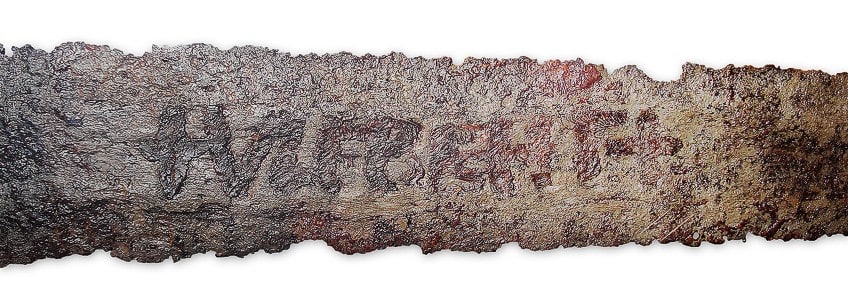
The ongoing use of the name may imply that manufacturing remained in the same studios after the original producers died, similar to a modern family enterprise, but it is also likely that these labels were viewed as a guarantee of excellent quality, or were considered stylish at the time. Metallurgical examination of certain “Ulfberht” blades found that they are actually of lower grade than expected.
Viking swords were status symbols as well as weapons, thus these low-quality Ulfberht swords were most likely the equal of today’s cheap knockoff Louis Vuitton purses.
Oseberg Heads (c. 9th Century)
| Date | c. 9th century |
| Artist | Unknown |
| Medium | Wood |
| Current Location | Museum of Cultural History, Oslo, Norway |
The burial ship uncovered in 1904 at the Oseberg farm in Tonsberg in Norway’s Vestfold area was one of the most mysterious and undeniably spectacular Viking discoveries. Longships were frequently employed by Vikings as vehicles for the deceased wealthy people and their belongings.
Consideration was taken to ensure the passengers had enough accessories to ensure a successful afterlife – much like the Ancient Egyptians.
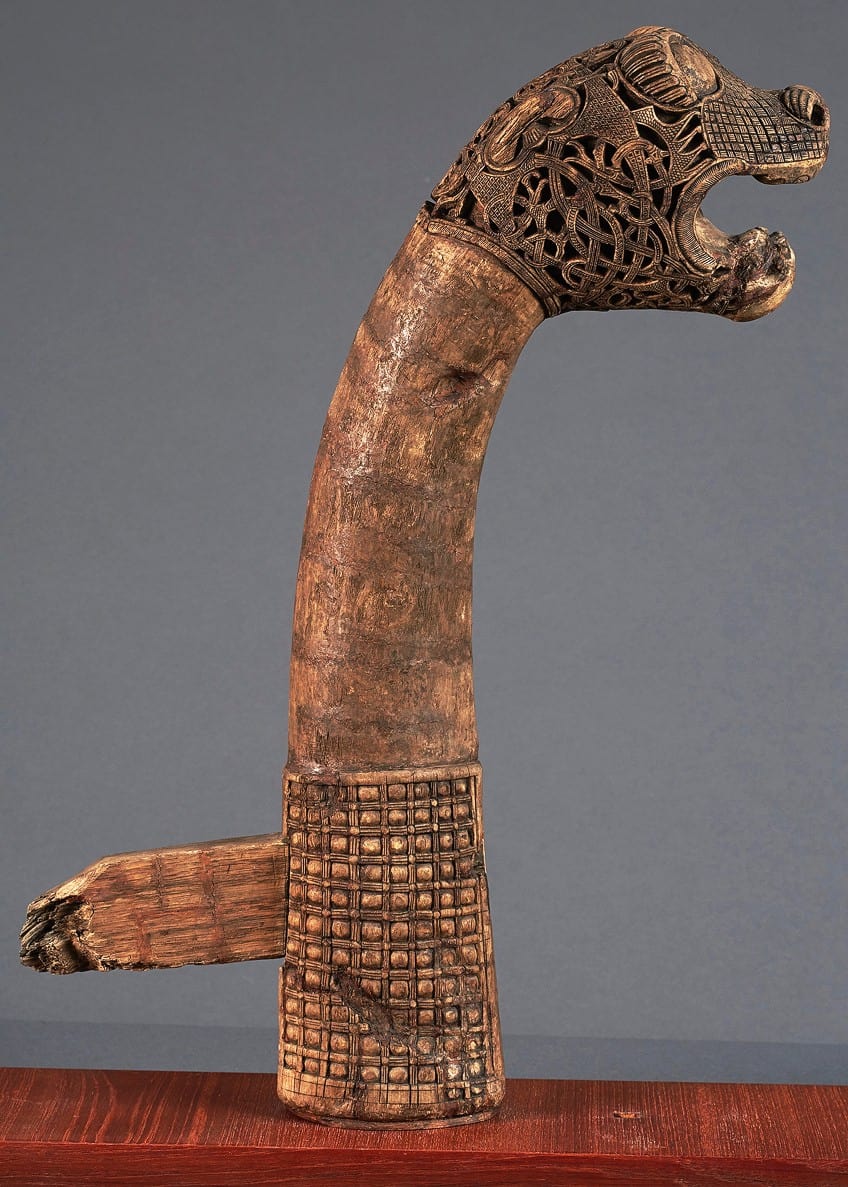
The vessel was made entirely of oak and marked with intricate carvings, and was crammed with Viking relics such as a chariot, a bucket featuring a Buddha-like figure made from brass, several animals, tents, and corpses of two females of high social standing. The most interesting of the finds there though were five animal heads intricately carved from stone.
It took five craftsmen to create a single piece, yet their purpose remains unknown.
Coppergate Excavation (c. 9th Century)
| Date | C. 9th century |
| Artist | Unknown |
| Medium | Thousands of artifacts |
| Current Location | Jorvik Viking Center, York, United Kingdom |
The discovery of a “hidden Viking metropolis” beneath the streets of York generated international news in the 1970s. Archaeological findings from the Viking era had previously been unearthed here purely by coincidence – but all shifted when the city government planned renovation in Coppergate, one of the city’s medieval avenues.
A tiny dig headed by York Archaeological Trust had previously revealed that the region had exceptional archaeological potential – and they were correct.
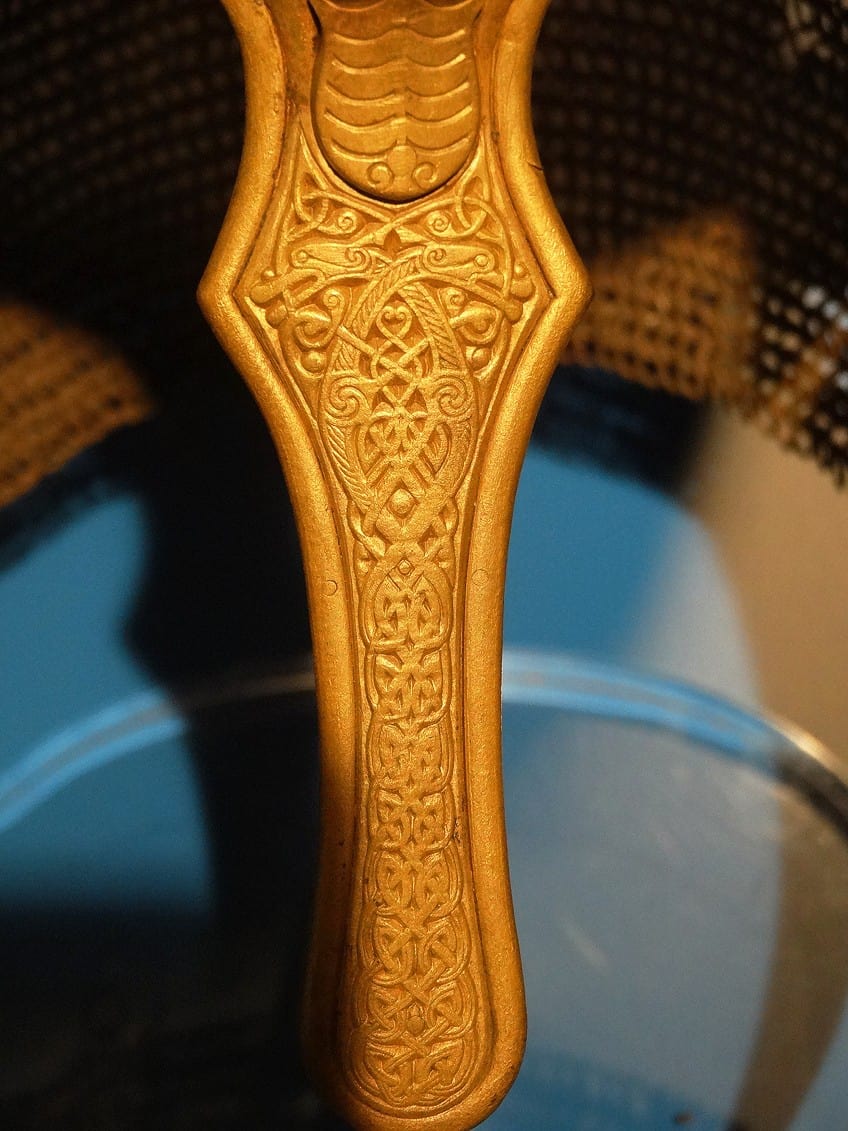
Rare evidence of Viking structures was discovered within a few days of the Coppergate reconstruction work. A large-scale excavation site was quickly established. A team of 12 experienced excavators and scores of volunteer archaeologists excavated 40,000 Norse artifacts from the area between 1976 and 1981.
Five tons of animal bones, thousands of medieval and Roan roof tiles, and a quarter-million pieces of pottery were discovered.
The Harrogate Hoard (c. 900 AD)
| Date | c. 900 AD |
| Artist | Unknown |
| Medium | Silver coins, cups, and other objects |
| Current Location | National Museum, Scotland |
In 2007, a man using a metal detector found what is regarded as the most significant Viking hoard discovered in more than 150 years in the British Isles. It was a cup filled with coins and other objects that had been buried in the early 900s. It revealed the vast range of exploration and plundering by the Vikings that stretched across four continents.
This significant find included artifacts and coins from Ireland, Afghanistan, Scandinavia, and Russia.
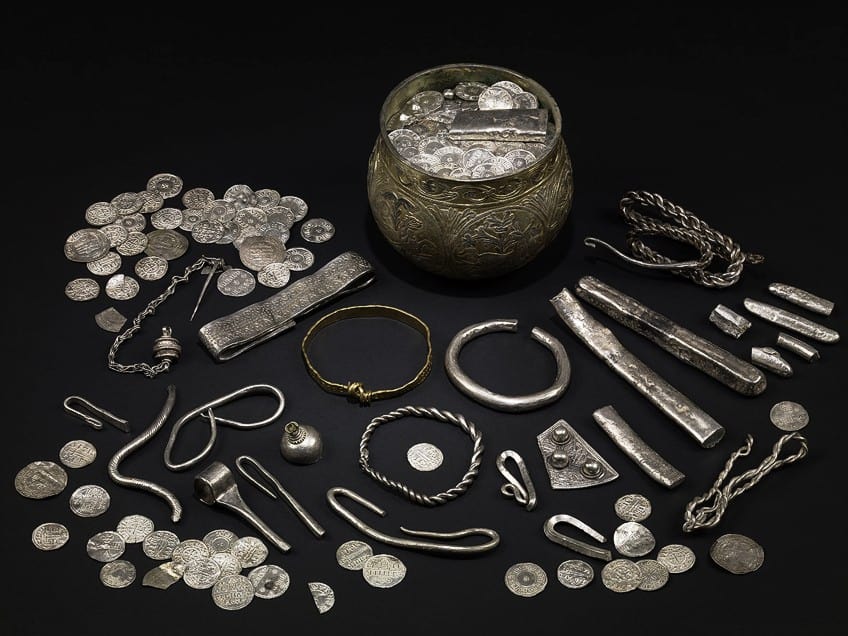
The worship of Thor, Christianity, and Islam are all represented in this incredible discovery, as well as the use of more than seven languages. The cup itself was most likely plundered during the raid of a German or French church where such cups were commonly used in various religious ceremonial settings.
Cuerdale Hoard (905 AD)
| Date | 905 AD |
| Artist | Unknown |
| Medium | Thousands of artifacts |
| Current Location | British Museum, London, United Kingdom |
The Cuerdale Hoard, a silver cache recovered more than 150 years ago, is said to be the biggest Viking hoard ever unearthed in England. It was discovered in 1840, when workers in Lancashire came upon a lead chest while repairing the River Ribble embankment at Cuerdale, near Preston. The treasure is remarkable for illustrating the international breadth of Viking activity, comprising more than 30kg of metal and an amazing 7,000 coins.
It is believed to have been placed about 905 AD, with its contents traced to Ireland, the Frankish realm, and the Middle East.

Silver was popularly used as a kind of currency in Viking times, and the Cuerdale Hoard reflects incredible riches. There are several potential theories concerning its origin and function, one of which is that it was a war chest gathered by Vikings banished from Dublin. The Ribble Valley was a major trade route between the Irish Sea and Viking York, and some scholars believe the riches were part of a conspiracy to retake Dublin from a stronghold on the estuary.
Hiddensee Hoard (c. 10th century)
| Date | c. 10th century |
| Artist | Unknown |
| Medium | Gold penchants, broch, neck-ring |
| Current Location | Museum der Hansestadt Stralsund, Germany |
The expansion of Viking ornamentation reflects the growth of its culture. This trove was discovered more than 100 years ago on the island of Hiddensee, off the coast of Germany. The stunning items – a brooch, pendants, and spacers – were most likely created in a royal studio in Denmark.
The hoard washed up on Neuendorf’s beach after major floods in 1872 and 1873, and it was found by a local fisherman.
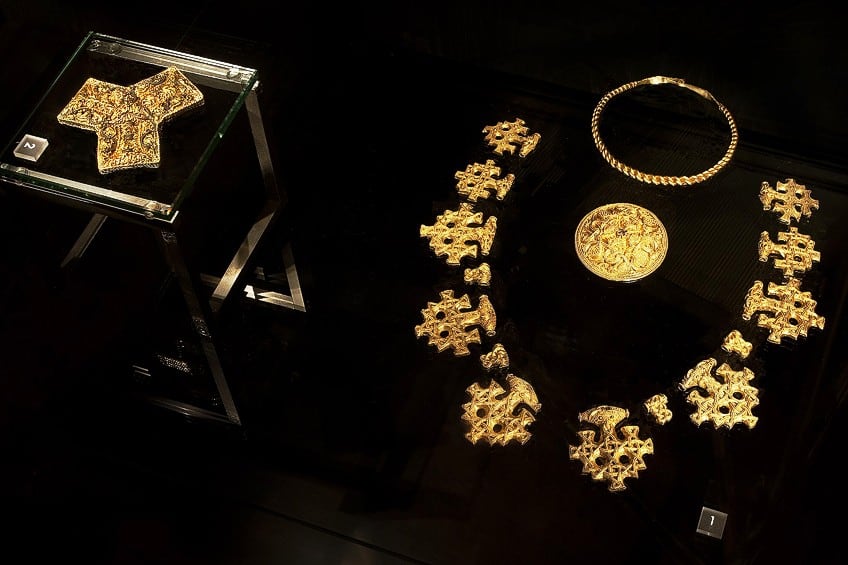
All of the pendants have a cross design and are made up of a hollow tube shaped like the head of a bird, most likely an owl or an eagle. The extended and twisted design of these artifacts may be found on a variety of Viking-era ornaments. The blend of Christian and Pagan symbols illustrates Christianity’s growing prominence in the 10th century, making those pendants fascinating in their historical context.
The Gjermundbu Helmet (c. 10th Century)
| Date | c. 10th century |
| Artist | Unknown |
| Medium | Iron |
| Current Location | University of Oslo, Norway |
Despite popular belief, Viking helmets lacked horns and don’t seem to have ever had any. Not that we are aware of at least, given there is relatively little information available about Viking helmets overall, other than the assumption that they were most likely worn. The majority of Viking portrayals were produced 100s of years after their initial attacks (the notorious horned helmet was a 19th-century opera aesthetic choice), with only wood carvings and later “picture stones”, occasionally used as grave markers, providing current clues to how the Vikings regarded themselves.
However, this artifact was meticulously repaired after being discovered in nine shards among a stockpile of weapons and other burial artifacts.
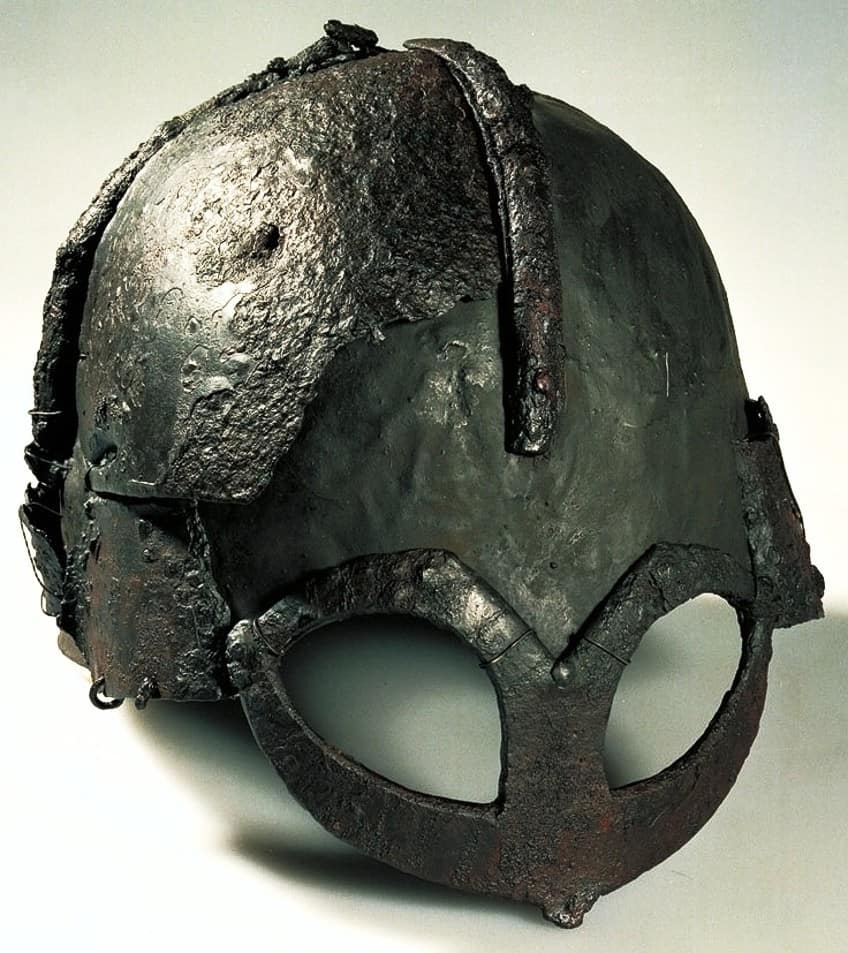
It resembled pre-Viking Scandinavian helmets, complete with chainmail beards, ceremonial figures, and a distinctive ‘spectacled’ eye guard. Except for a few shards, this and another example unearthed in the 1950s are the only two Viking helmets ever discovered.
Ardnamurchan Burial (c. Early 10th Century)
| Date | c. Early 10th century |
| Artist | Unknown |
| Medium | Viking burial boat fragments and objects |
| Current Location | The British Museum, London |
Archaeological digs on Scotland’s west coast in the summer of 2011 unearthed the only known Viking burial boat discovered on the British mainland in current times. The vessel remains in the form of almost 200 rivets, many of which were still in their original place and suggested a compact clinker vessel.
It included an axe, a spear, a sword, an Irish bronze ring-pin, a ladle, and a drinking horn’s bronze rim.
These Viking artifacts imply an extremely wealthy Viking boat burial of a warrior. The first time the public would see this monumental discovery was in 2014 at the British Museum. The Ardnamurchan boat burial was located next to the Roskilde 6, and portrays a Viking warrior’s ultimate voyage, sailing into the hereafter.
Hogback Tombstone (c. 10th Century)
| Date | c. Early 10th century |
| Artist | Unknown |
| Medium | Stone |
| Current Location | The British Museum, London, United Kingdom |
Hogbacks are Scandinavian stone sculptures from Scotland and England that are commonly used as burial markers or stylized residences for the deceased. The hogback evolved from several sources, the most prominent of which had Scandinavian and Anglo-Saxon origins. Although hogbacks are not seen in Scandinavia, they are thought to be a one-of-a-kind innovation of the Viking immigrants in Northern England.
It has been proposed that the monument type was developed in the late 9th century, under the reign of Viking rulers in York.

The embellishment on hogbacks, which was heavily inspired by the Jellinge and Borre styles that debuted in Scandinavia in the early 10 century, has led to a 10th-century dating being widely accepted. There are similarities between many hogbacks and Viking-Age long houses that are caused not just by the form and contours of the hogback monuments, but also due to their portrayal of architectural-looking elements.
Roskilde 6 (1025)
| Date | 1025 |
| Artist | Unknown |
| Medium | Viking wooden ship |
| Current Location | National Museum of Denmark |
This is the world’s longest Viking ship ever discovered and it was a huge engineering marvel for its time. It was unearthed during construction work to expand the Viking Ship Museum in Roskilde Fjord in 1997 and has since been expertly preserved by the National Museum of Denmark.
The Roskilde 6 signifies the Vikings’ rather significant seafaring advantages, and it characterizes their progress.
Because of this technical advancement, the seas became an opportunity, a gateway to other countries, rather than a barrier. Roskilde 6 was designed as a warship: light and shallow, she could sail at fast speeds, manned by up to 100 raiders who could attack their unsuspecting adversaries by sea.
The attackers could plunder with brutal efficiency once they arrived, as many a coastal village or prosperous monastery learned.
Winchester Manuscript (1031)
| Date | 1031 |
| Artist | Unknown |
| Medium | Manuscript |
| Current Location | The British Library Board, United Kingdom |
Cnut the Great, subsequently king of Denmark, ruled England from 1016 until 1035. He was without question the most influential ruler in Viking-age Scandinavia. The sole known image of him and his English bride, Emma, can be seen in this exquisite artwork from the New Minster Liber Vitae at Winchester.
The Vikings created new kingdoms in Ireland and Britain in the early 10th century, and by approximately 950 AD, there was something resembling a single, united English monarchy.

This kingdom’s crown was taken following a period of intensive raids, first by Svein Forkbeard in 1013, and subsequently by Cnut, his son. His kingdom was centered in England, and his rule introduced with it a time of stability. The new king worked hard to establish himself as a Christian ruler and a substantial financial supporter of the church, as seen by this double image in which he is depicted as an Anglo-Saxon monarch despite his Danish ancestry.
The Lewis Chess Pieces (c. 1150 AD)
| Date | c. 1150 AD |
| Artist | Unknown |
| Medium | Walrus ivory and whale tooth |
| Current Location | The British Museum, London, United Kingdom |
In the early 19th century, one of the most startling Viking-era artifacts were discovered on a beach near Uig on Scotland’s Isle of Lewis. The exact date and method of discovery are unknown, however, one of the villagers of Peighinn Dhomhnuilli, Malcolm Macleod, is frequently credited with discovering them under a crumbled sandbank in 1831.
All that is clear is that they appeared later that year at the Society of Antiquaries of Scotland, where they were a topic of intrigue and conjecture that continues to this day.
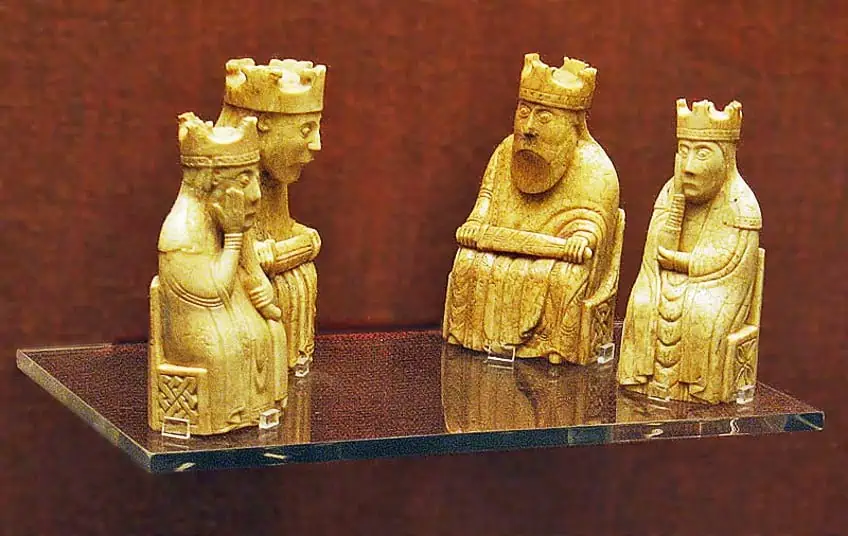
Examination and study of the carved walrus ivory and whale tooth pieces, which measure roughly 10 centimeters in length and comprise 93 identified individuals, have revealed a Scandinavian provenance around 1150 AD – perhaps Trondheim in Norway.
Weighing Scales (c. 1000)
| Date | c. 1000 |
| Artist | Unknown |
| Medium | Copper alloy |
| Current Location | Berlin State Museum, Germany |
In the ninth century, contact with the Islamic world brought the use of precious metals as a form of commerce. Over 100,000 Islamic silver coins have been discovered in Viking-age Scandinavia. However, because the bullion value was what kept the economy going, the precious metal was frequently melted down and transformed into movable ingots.
Although bullion did not have the formal quality control associated with coinage, it did offer an adaptable system.
This was because it could be cut up and utilized in any proportion. The usage of bullion necessitated weight measurement, and we can see the Islamic world’s impact in a set of foldable balances and weights. Scales like this may be discovered as far west as Ireland in the Viking era.
Today, Viking artifacts are found all around the world where the seafaring people had once traveled to. These Viking relics can help historians trace the path of the spread of Viking power and dominance. Besides the Viking swords and Norse mythology artifacts that are unearthed, much of the Viking riches discovered were in fact hoards of coins, jewelry, and other riches plundered from the regions they terrorized.
Take a look at our ancient Viking artifacts webstory here!
Frequently Asked Questions
Why Did Vikings Plunder Other Lands?
There are several theories as to why the Vikings left their homeland in the first place. Some historians speculate that it might have had something to do with a large amount of rural land and the lack of towns that caused many Vikings to leave in search of greener pastures and riches abroad. With an ever-growing population, work opportunities would not have been abundant, as the land plots were very small. This meant that they could not produce enough crops to make any sort of profit. Another potential reason cited was the tribal territorial conflicts that were rife during that era. Along with the merchant’s tales of riches abroad, these factors lead to many Vikings climbing on ships and heading off to foreign shores.
What Is the Most Valuable Viking Glass?
A small glass Viking artifact was unearthed in Lindisfarne, an island just off Northumberland. Although one cannot put a monetary value on the Norse artifact, it is said to have great cultural significance. It is a piece of a game from the Viking era called hnefatafl that was very popular in the region until the introduction of chess a few centuries later. The craftsmanship of the artifact is said to be of incredible workmanship and must have originally belonged to a member of the elite classes.
Jordan Anthony is a Cape Town-based film photographer, curator, and arts writer. She holds a Bachelor of Art in Fine Arts from the University of the Witwatersrand, Johannesburg, where she explored themes like healing, identity, dreams, and intuitive creation in her Contemporary art practice. Jordan has collaborated with various local art institutions, including the KZNSA Gallery in Durban, the Turbine Art Fair, and the Wits Art Museum. Her photography focuses on abstract color manipulations, portraiture, candid shots, and urban landscapes. She’s intrigued by philosophy, memory, and esotericism, drawing inspiration from Surrealism, Fluxus, and ancient civilizations, as well as childhood influences and found objects. Jordan is working for artfilemagazine since 2022 and writes blog posts about art history and photography.
Learn more about Jordan Anthony and about us.
Cite this Article
Jordan, Anthony, “Viking Artifacts – Exciting Viking Relics That Have Been Found.” artfilemagazine – Your Online Art Source. October 11, 2022. URL: https://artfilemagazine.com/viking-artifacts/
Anthony, J. (2022, 11 October). Viking Artifacts – Exciting Viking Relics That Have Been Found. artfilemagazine – Your Online Art Source. https://artfilemagazine.com/viking-artifacts/
Anthony, Jordan. “Viking Artifacts – Exciting Viking Relics That Have Been Found.” artfilemagazine – Your Online Art Source, October 11, 2022. https://artfilemagazine.com/viking-artifacts/.


